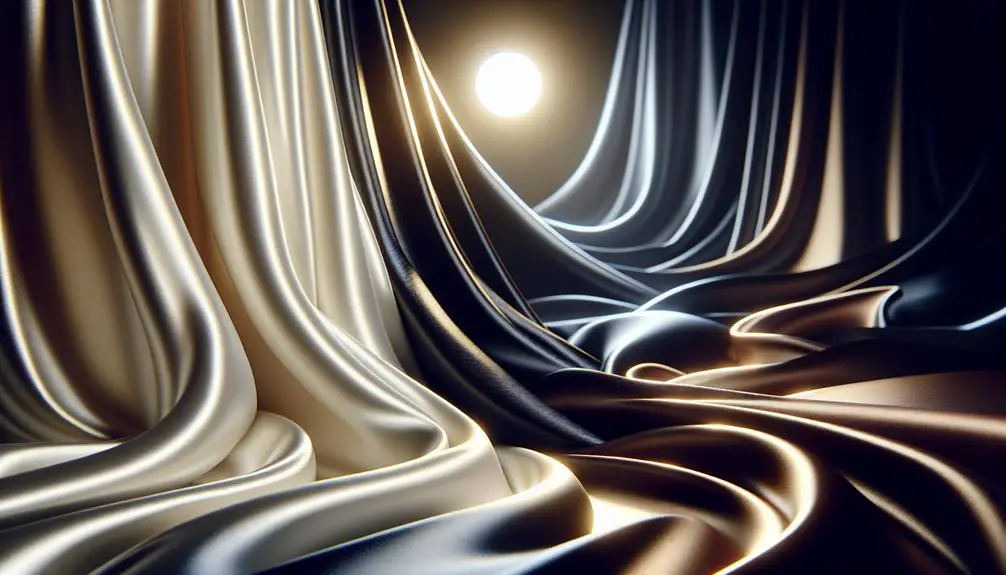So, we're diving into the silk vs. satin debate, huh? Well, I've always leaned towards silk because of its undeniable quality and feel. It's not just about the luxurious touch or the fact that it's natural, but also how it practically benefits your skin and sleep. Sure, satin might give you that smooth experience at a fraction of the cost, but can it really match silk's hypoallergenic properties or its durability? There's a lot beneath the surface of this comparison. Stick around, and let's unpack the nuances that really set silk apart. Trust me, it's more than just a price tag difference.
Table of Contents
Key Takeaways
- Silk is a natural fiber with inherent hypoallergenic, moisture-wicking, and temperature-regulating properties, unlike synthetic satin.
- Due to its complex production process, silk offers superior durability and quality, making it more expensive but justifying its cost.
- Silk's natural sheen and softness are unmatched by satin, providing a luxurious feel and appearance that synthetic fibers cannot replicate.
- The comfort and health benefits of silk, including less irritation and better skin and hair health, surpass those offered by satin.
- Silk maintains its quality and texture over time, whereas satin may lose its luster and smoothness with frequent washing and wear.
Understanding Silk
Silk, a luxurious natural fiber spun by silkworms, boasts a soft and smooth texture that's unparalleled in the textile world. It's all about the vibe it gives off, right? You touch silk, and it's like your skin's being pampered by the softest thing ever. This isn't just any fabric; it's a weave of history and quality, spun from the cocoons of the bombyx mori. These little critters are picky eaters, munching exclusively on mulberry leaves, but their diet is what makes silk so darn special.
Weaving silk isn't just about throwing threads on a loom; it's an art. The threads need to be harvested, which means waiting for the silkworm to spin its cocoon and then delicately unraveling that pod without breaking the thread. That's where the magic happens. This process gives silk its hypoallergenic property, making it a go-to for anyone with sensitive skin.
And let's talk versatility. Silk isn't just for show; it's durable, breathable, and has this cool feature of being insulating yet moisture-wicking. Whether it's freezing or you're sweating buckets, silk's got your back, keeping you comfy. It's the fabric that keeps on giving, blending luxury with practicality.
Exploring Satin
Now, let's talk about satin.
It's pretty cool because it can be made from a bunch of different fibers, which means there's a lot of variety in what you can get.
Plus, it's got this awesome glossy look and feels super smooth, kind of like silk but with its own twist.
Satin Composition Varieties
Exploring the world of satin reveals its remarkable versatility, with compositions ranging from polyester to silk, each offering its own unique allure. The weave pattern of satin, especially in silk satin, gives it that shiny, smooth appearance we all adore.
Here's a quick look at some satin varieties:
| Type | Fiber Base | Characteristics |
|---|---|---|
| Silk Satin | Silk | Luxurious, smooth |
| Polyester Satin | Polyester | Durable, less expensive |
| Cotton Satin | Cotton | Breathable, soft |
| Nylon Satin | Nylon | Strong, lightweight |
| Acetate Satin | Acetate | Glossy, crisp |
Each type brings something special to the table, from the supple elegance of silk satin to the practical appeal of polyester. It's this diversity that makes satin a go-to for creating a range of looks, blending sheen with substance.
Satin's Unique Characteristics
Having looked at satin's diverse compositions, let's focus on what sets its characteristics apart. You see, satin's magic lies in its weave pattern. Whether it's made from silk, polyester, or any other material, the satin weave gives it that unmistakable glossy surface we all love. This isn't just any shine; it's a luxe, smooth finish that makes everything from sheets to dresses feel extra special.
And here's the kicker: even though satin can be made from natural fiber like silk, it doesn't always offer silk's natural benefits. Yet, this doesn't detract from its appeal. Whether it's cotton satin, polyester satin, or silk satin, each type brings its own game with a luxurious feel that's hard to match. It's this versatility and glossy charm that truly sets satin apart.
Silk Vs. Satin
I'm diving into the silk vs. satin debate to see why many think silk's the real deal. When we break it down, it's clear that while both may offer that sleek, luxurious feel, silk and satin are fundamentally different beasts, each with its own set of strengths and weaknesses. But if we're talking about pure quality, silk takes the crown, and here's why:
- Origin: Silk is a natural fiber produced by silkworms, unlike satin, which is a weave that can be made from a variety of fibers, including silk but often synthetic ones.
- Feel and Durability: Nothing beats the softness and durability of silk, thanks to its natural protein structure.
- Health Benefits: Silk's natural properties, such as being hypoallergenic and moisture-wicking, make it the go-to for anyone looking to enhance their skin and hair health.
- Temperature Regulation: Sleeping in silk can keep you cool in the summer and warm in the winter, a benefit synthetic satin can't fully match.
- Luxury Factor: The natural sheen and feel of silk scream luxury in a way that even the best satin can't mimic.
Benefits of Silk
So, let's talk about why silk is such a game-changer, especially when it comes to our health and comfort.
Being made of natural protein fibers, it's not just kind to the skin but also packs a punch with its skin health advantages.
Plus, the superior comfort and feel it offers is pretty hard to beat, making it a top pick for anyone looking to upgrade their sleep game.
Natural Protein Fibers
Silk's a natural protein fiber that stands out for its unique blend of luxury and practical benefits. When you're eyeing up silk bedding or comparing it to satin fabric, it's crucial to understand the core differences between these two.
- Breathability: Silk lets your skin breathe, unlike many satin options.
- Moisture Absorption: It wicks away sweat, keeping you dry and comfortable.
- Hypoallergenic: A blessing for sensitive skin, warding off irritation.
- Durability: While delicate, silk has a surprising strength, outlasting synthetic satin.
- Temperature Regulation: Keeps you cool in summer and warm in winter, a true game-changer.
Grasping these characteristics, it's clear why silk holds a premium spot in the world of fabrics.
Skin Health Advantages
Diving into how silk benefits your skin, it's a game-changer for anyone after healthier, smoother skin. If you've got sensitive skin like me, you're always on the lookout for anything that doesn't trigger irritation. That's where silk swoops in. It's hypoallergenic, pushing away nasties like mold and mites that love to mess with your skin.
Plus, it locks in moisture, keeping your skin from drying out and looking dull. Ever woke up with those weird sleep lines on your face? Silk's smooth texture means less friction, which equals fewer sleep lines and wrinkles. And let's not forget, it keeps your skin feeling just right temperature-wise, which is a big thumbs up for your skin health.
Honestly, switching to silk was a no-brainer for me.
Superior Comfort and Feel
When you first touch silk, you immediately notice its unmatched comfort and luxurious feel, setting it apart from synthetic options like satin.
- Silk's softness is way beyond what you get with satin; it's like the difference between a gentle breeze and a synthetic fan – both cool you down, but one feels natural, and the other, well, doesn't.
- Smooth fabric without the slipperiness of satin, making it more comfortable to wear or sleep in.
- Breathable qualities ensure you stay cool in summer and warm in winter, unlike satin.
- Moisture-wicking abilities keep you dry, enhancing comfort especially on hot nights.
- Hypoallergenic nature means no sneezing or itching, just pure bliss.
Silk's natural properties provide a comfort level satin simply can't match.
Drawbacks of Satin
Despite its smooth feel, satin's got a few downsides worth mentioning. First off, satin sheets are less breathable and that's a biggie for anyone living in warmer climates or for those who are hot sleepers. No one likes waking up feeling like they've been in a sauna, right? This leads to another point: satin retains heat. If you're the type who's always turning the AC down, satin might not be your best friend at bedtime.
| Issue | Why It's a Problem | Who It Affects Most |
|---|---|---|
| Less Breathable | Leads to discomfort in warm climates | Warm climate dwellers |
| Retains Heat | Not ideal for hot sleepers | Hot sleepers |
| Prone to Snagging | Affects smooth surface and appearance | Anyone looking for durability |
Cleaning these sheets can be a bit of a hassle, too. They need the gentle cycle, and let's be honest, who's got time for that? Plus, they snag easily which can ruin that sleek look everyone's after. Sure, they're wrinkle-resistant to a degree, but if you want them looking sharp, you might still need to whip out the iron or steamer. So, while they've got their perks, these drawbacks are something to keep in mind.
The Production Process
Understanding the production process reveals why silk is often considered higher quality than satin. Silk's journey from silkworm cocoon to luxurious fabric is both complex and fascinating. It's a natural, painstaking process that results in a material known for its breathability, hypoallergenic properties, and sheer luxe feel.
On the flip side, satin is a weave, not a material, and it can be made from anything—cotton, wool, or more commonly, synthetic fibers like polyester. This versatility means satin can mimic the look of silk but doesn't quite match up in terms of quality, especially when it's made from synthetic materials.
Here's a quick rundown to get the point across:
- Silk production is labor-intensive, involving cocoon harvesting and silk reeling.
- Satin is a type of weave that can be made from synthetic, lacking silk's natural charm.
- The top silk producers, like China and India, are experts in crafting this exquisite material.
- Polyester satin, while durable and sheeny, doesn't offer silk's breathability or eco-friendliness.
- The natural properties of silk—hypoallergenic, breathable, luxurious—set it apart from synthetic satin.
Durability Comparison
Let's get into the nitty-gritty of which is more durable: silk or satin.
I've found that silk's natural fibers give it a leg up in lasting longer and resisting wear and tear better than satin.
Considering how often we use and wash our bedding, that difference in durability really matters.
Silk Vs. Satin Strength
When we pit silk against satin in terms of strength, silk usually takes the crown due to its natural fiber makeup. Let's dive a bit deeper into why that's the case:
- Silk's durability isn't just talk; it's backed by its natural properties.
- The resilience over time silk offers is nothing short of impressive.
- Maintaining a luxurious feel, even after many uses, speaks volumes about silk's strength.
- While satin can be durable, its strength varies significantly depending on the fibers used.
- Ultimately, when talking silk vs. satin strength, silk's natural fiber composition gives it a solid edge.
In the world of fabrics, understanding these nuances is key to mastering what works best for your needs.
Wear and Tear Resistance
In comparing silk and satin, it's clear that silk's resilience gives it an edge in resisting wear and tear. Silk's got this natural toughness, right? It's not just about looking good; it's durable, strong, and can handle a lot of friction without showing signs of distress. That means for anything that's getting daily use, like your favorite blouse or those luxury sheets, silk is your go-to for longevity.
Satin might look and feel similar, but it doesn't have the same muscle against daily wear. It's because satin can be made of anything, not just silk fibers, so its wear resistance can't quite match up. Bottom line? Silk's durability is top-notch, keeping things looking classy without giving in to the rough and tumble.
Longevity of Materials
Building on how silk shows up satin in wear and tear, it's worth noting that this same resilience plays a big role in the materials' longevity. Silk's durability isn't just a buzzword; it's a promise of years of elegance with the right care. And while satin might shine for a season, its sparkle dims next to silk's enduring glow.
- Silk's natural strength means it can last years.
- Synthetic satin fades faster than silk's steadfast quality.
- Silk resists wear, keeping its luxe look over time.
- Silk-based satin outperforms synthetic versions in the long run.
- Proper care turns silk's durability into decades of use.
Understanding these points, it's clear silk's longevity is unmatched, offering true value and enduring beauty.
Aesthetics and Feel
Often, people find silk's natural sheen and smooth texture more luxurious and appealing than satin's glossy but sometimes synthetic feel. It's not just about looks; it's the touch, the way silk drapes over your skin like a gentle whisper, that sets it apart. Silk and satin, when you get down to it, are worlds apart in both feel and appearance.
Digging deeper, silk's indulgent, sumptuous feel is hard to match. There's something about its natural luster that screams elegance, making you feel like you're wrapped in pure luxury. Satin tries, bless its heart, to mimic that glossy look, but often ends up feeling a bit more artificial. It's like comparing a perfectly ripe, juicy peach to a well-done imitation—it's just not the same.
The tactile experience of silk is renowned for a reason. Its premium quality isn't just about how it looks; it's how it makes you feel. Running your hands over silk, you can't help but feel a bit more posh, a bit more sophisticated. It's that sensuousness, that undeniable premium touch, that leaves satin trailing behind, trying to catch up.
Health and Beauty Advantages
Silk's not just a treat for the eyes; it's a boon for your health and beauty too, thanks to its hypoallergenic and antibacterial properties. When I swapped my regular bedding for silk sheets, the difference was night and day, not just in the luxurious feel, but in how my skin and hair responded. Let's not forget, mastering the art of beauty sleep isn't just about the hours you clock in; it's about what you're sleeping on.
- Hypoallergenic Haven: Silk's natural resistance to mold, mites, and fungi is a game-changer for allergy sufferers like me.
- Moisture Magic: Its moisture-wicking properties keep my skin hydrated and my hair smooth, reducing breakage and frizz.
- Temperature Tamer: Whether it's a hot summer night or a chilly winter evening, silk sheets adjust, ensuring I'm never too hot or too cold.
- Skin Savior: The gentle touch of silk versus rough cotton has noticeably reduced my skin's irritation and dryness.
- Beauty Boost: The natural shine and quick-drying aspect of silk not only look good but contribute to healthier hair and skin over time.
Silk sheets truly bridge the gap between luxury and practicality in health and beauty.
Making the Right Choice
After exploring the health and beauty advantages of silk, it's time to consider why opting for silk over satin is the smarter choice for your bedding needs. When we dive into the satin vs silk debate, it's crucial to remember that while they may share a similar look, the substance they're made from separates them miles apart.
| Feature | Silk | Satin |
|---|---|---|
| Origin | Natural (Silkworms) | Synthetic fibers |
| Comfort | Breathable, Moisture-wicking | Less breathable |
| Durability | High | Varies |
Silk, being a natural fiber, not only feels more luxurious but also comes packed with benefits that synthetic fibers can't mimic. Its superior temperature regulation and moisture-wicking abilities make it a clear winner for me. I mean, who doesn't want to wake up feeling fresh and not sweaty, right?
Choosing silk means I'm investing in quality sleep and, in the long run, my skin and hair health. Sure, satin might look the part and often comes with a lower price tag, but it falls short on delivering the comfort and luxury I crave. For those of us looking to master our sleep experience, silk is the obvious choice.
Frequently Asked Questions
Which Is Better Quality Satin or Silk?
I'd say silk's the better pick. It's all-natural, super breathable, and feels luxurious. Plus, it's hypoallergenic and lasts longer. Satin might look similar, but it doesn't offer the same quality or benefits as silk.
Is Silk or Satin More Expensive?
I've learned that silk typically costs more than satin. This is because silk's natural and requires more work to produce, while satin can be made from cheaper synthetic materials. So, silk's the pricier choice.
Which Lasts Longer Silk or Satin?
I've found that silk generally outlasts satin due to its natural durability. While satin's lifespan varies with its fiber content, silk maintains its quality for years, making it a longer-lasting choice for me.
Does Silk Wrinkle More Than Satin?
Actually, silk wrinkles less than satin because of its natural elasticity and smooth fibers. It's why I choose silk for a sleek look with minimal effort. Silk stays smoother, making my life easier.
- The Evolution of Textile Patterns Over Time - July 17, 2024
- Traditional Fabrics: A Journey Through Cultures - July 17, 2024
- Fabric Dyeing: Techniques and History - July 17, 2024






